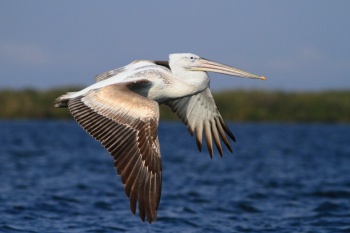- Pelecanus crispus
Identification
Length 160-180 cm (63-70¾ in), wingspan 310-345 cm, weight 10-13 kg
- Grey white plumage.
- Curly nape feathers.
- Wings with dark brown primaries and secondaries, and dusky wing coverts, giving diffuse pattern above; mainly white to pale grey below with just primaries and secondaries diffusely dark-tipped.
- Yellow to purple bare skin around eyes.
- Orange-red gular pouch when breeding starts; becomes yellow later.
- Dark grey legs.
Similar species
Great White Pelican has a sharply defined black-and-white wing pattern; juveniles and immatures less distinct, but with more black on underwing.
Distribution
Breeds southern Europe and central Asia, in Albania, Bulgaria, Romania and Greece east through Turkey and Kazakhstan to Xinjiang in China; winters south to Iran and India. Formerly much more widespread, including northwest to the Somerset Levels in Somerset, England, where it became extinct probably during Roman or mediaeval times due to hunting and persecution by fishing interests.
Taxonomy
This is a monotypic species[1].
Habitat
Shallow lakes, coastal lagoons, river deltas and swamps.
Behaviour
Breeding
It is a colonial breeder, nesting on mud islets or piles of vegetation in reedbeds.

Photo © by Alok Tewari
Keoladeo National Park, Bharatpur, Rajasthan, India, December-2018
Diet
The diet consists almost entirely of fish, particularly, carp, perch and rudd.
Vocalisation
Calls: Hissing and grunting.
References
- Clements, J. F., T. S. Schulenberg, M. J. Iliff, D. Roberson, T. A. Fredericks, B. L. Sullivan, and C. L. Wood. 2018. The eBird/Clements checklist of birds of the world: v2018. Downloaded from http://www.birds.cornell.edu/clementschecklist/download/
- Del Hoyo, J, A Elliot, and J Sargatal, eds. 1992. Handbook of the Birds of the World. Volume 1: Ostrich to Ducks. Barcelona: Lynx Edicions. ISBN 978-8487334108
- Wikipedia
- BirdLife International
Recommended Citation
- BirdForum Opus contributors. (2024) Dalmatian Pelican. In: BirdForum, the forum for wild birds and birding. Retrieved 25 April 2024 from https://www.birdforum.net/opus/Dalmatian_Pelican
External Links
GSearch checked for 2020 platform.1






